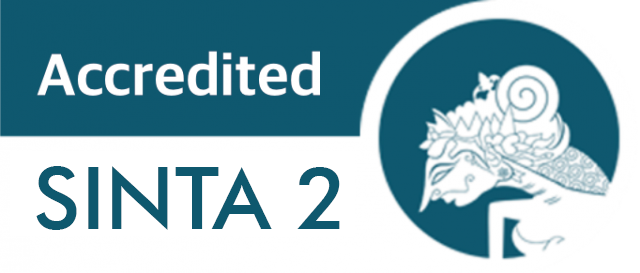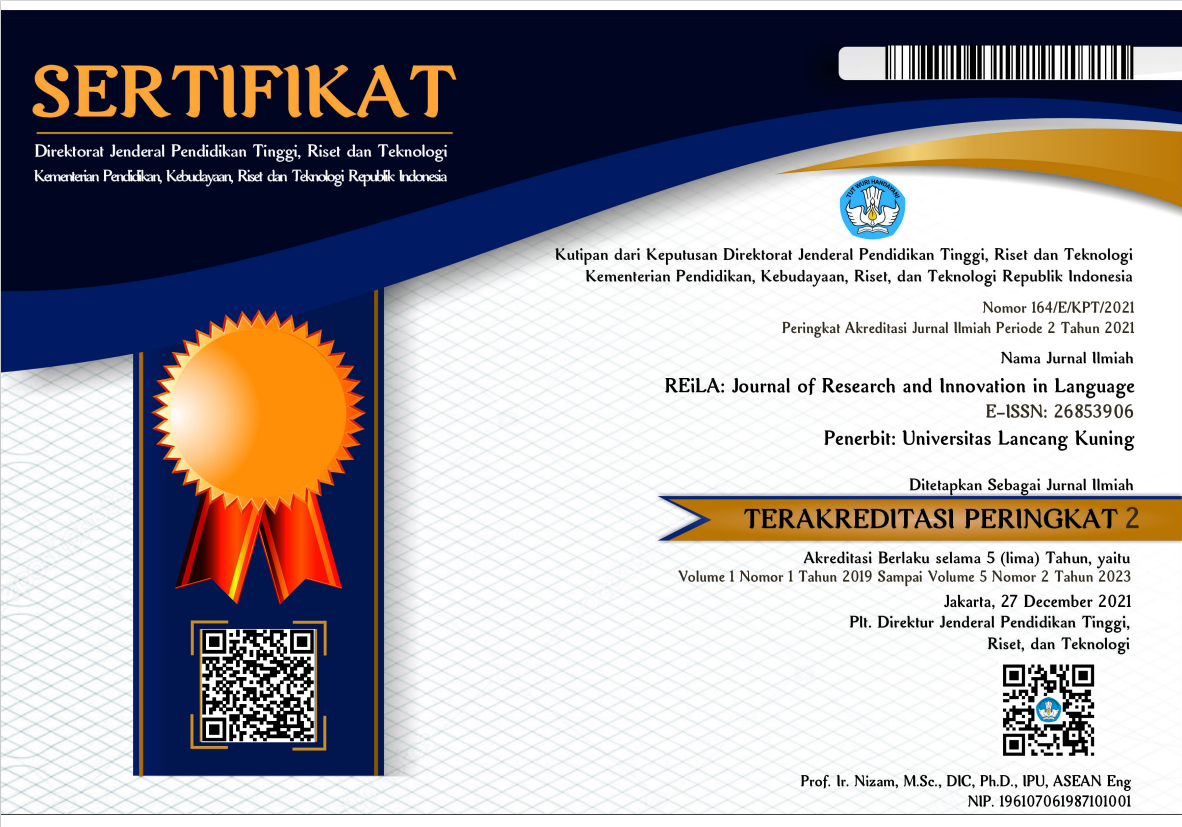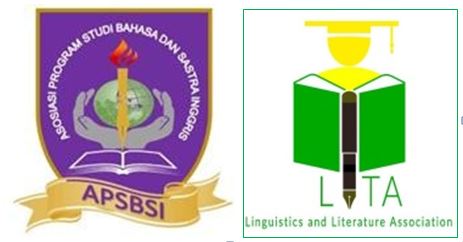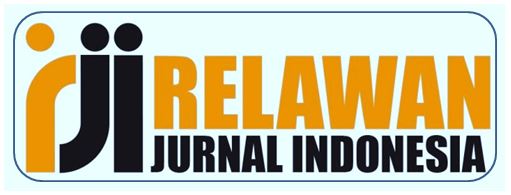The Effectiveness of Contextual Teaching and Learning Approach in Enhancing Indonesian EFL Secondary Learners’ Narrative Writing Skill
Abstract
This study investigates the effectiveness of the Contextual Teaching and Learning (CTL) approach in enhancing Indonesian EFL secondary learners’ narrative writing skills and the perception of Indonesian EFL secondary schools toward applying the CTL approach. This study employed a quasi-experimental design with fifty-two eleventh-grade students as participants. The participants were divided into two groups; An experimental group received the CTL approach, and a control group received the conventional way. This study utilized a pre-posttest and perceptional questionnaire. Nonparametric tests (i.e., Mann-Whitney U test and Wilcoxon test) were run to analyze the data in this study. The Man-Whitney U test indicated a significant difference between the mean score for the experimental group with the CTL approach and the control group without the CTL approach (9.86 > 10.12). Meanwhile, the Wilcoxon test illustrated that the leading score of the pre-test (10.14) and the post-test (16.05) in the experimental group differ significantly. Implementation of the CTL approach through its components positively contributes to teaching narrative writing skills. Meanwhile, the perceptional questionnaires showed that the students' experiment group perceived the implementation of the CTL Approach positively. This study results render teachers’ insight into a practical approach to teaching writing to be able to teach narrative writing.
Downloads
References
Abas, I. H., & Abd Aziz, N. H. (2018). Model of the Writing Process and Strategies of EFL Proficient Student Writers: A Case Study of Indonesian Learners. Pertanika Journal of Social Sciences and Humanities, 26(3), 1815–1842.
Adas, D., & Bakir, A. (2013). Writing Difficulties and New Solutions : Blended Learning as an Approach to Improve Writing Abilities. International Journal of Humanities and Social Science, 3(9), 254–266.
Afinogenova, N. V. (2021). Developing Writing Skills in Online and Offline Interaction. Social and Economic Aspects of Education in Modern Society, March, 3–6. https://doi.org/10.31435/rsglobal_conf/25032021/7460
Anderson, M., & Anderson, K. (1997). Text types in English. 2. Macmillan Education Australia.
Arianto, A. (2011). The implementation of Contextual Teaching and Learning in Teaching English. Journal on English as a Foreign Language, 1(2), 71-78. https://doi.org/10.23971/jefl.v1i2.190
Asriati, S., & Maharida, M. (2013). Improving The Students’ Writing Skill by Using Process Writing Approach at The Second Grade Students of SMK Grafika Gowa Makassar. EXPOSURE : Jurnal Pendidikan Bahasa Dan Sastra Inggris, 2(2), 224-244. https://doi.org/10.26618/ejpbi.v2i2.788
Ausebel, D. P. (2000). The acquisition and retention of knowledge: a cognitive view. Kluwer Academic Publishers.
Bagheri, M. S., & Zare, M. (2009). The Role of Using IELTS Model Essays in Improving Learners’ Writing and their Awareness of Writing Features. JELS, 1(1), 115–130. https://doi.org/http://dx.doi.org//20.77632/elt.v1n2p115
Baker, E. D., Hope, L., & Karandjeff, K. (2009). Contextualised Teaching & Learning: A Faculty Primer. A Review of Literature and Faculty Practices with Implications for California Community College Practitioners. In Academic Senate for California Community Colleges. https://files.eric.ed.gov/fulltext/ED519284.pdf
Berns, R. G., & Erickson, P. M. (2001). Contextual Teaching and Learning: Preparing Students for the New Economy. The Highlight Zone: Research © Work No. 5. In The Highlight Zone Research (Issue 5). https://doi.org/10.1111/j.1471-0528.2012.03397.x
Byrne, D. (1993). Teaching writing skill (New ed). London : Longman Group Ltd.
Cohen, A. D. (1994). Assessing language ability in the classroom (2nd ed). Heinle ELT.
Department of Education and Training. (2007). Writing and spelling strategies : Assisting students who have additional learning support needs. Disability Programs Directorate: Learning Assistance Program. https://cer.schools.nsw.gov.au/content/dam/doe/sws/schools/c/cer/localcontent/writingandspellingstrategies.pdf
Derakhshan, A., & Karimian Shirejini, R. (2020). An Investigation of the Iranian EFL Learners’ Perceptions Towards the Most Common Writing Problems. SAGE Open, 10(2), 1–10. https://doi.org/10.1177/2158244020919523
Dilidüzgün, Ş. (2013). The Effect of Process Writing Activities on The Writing Skills of Prospective Turkish Teachers. Eurasian Journal of Educational Research, 52(52), 189–210.
Fareed, M., Ashraf, A., & Bilal, M. (2016). ESL Learners’ Writing Skills: Problems, Factors and Suggestions. Journal of Education & Social Sciences, 4(2), 83–94. https://doi.org/10.20547/jess0421604201
Firdani, F., & Fitriani, S. S. (2017). Teaching writing through guiding questions technique to improve students’ writing skill. Research in English and Education Journal, 2(4), 41–52.
Gay, L. R., Mills, G. E., & Airasian, P. (2006). An education research : Competencies for analysis and application (8th ed). Columbus: Merrill Greenwood.
Glynn, S. M., & Winter, L. K. (2004). Contextual Teaching and Learning of Science in Elementary Schools. Journal of Elementary Science Education, 16(2), 51–63. https://doi.org/10.1007/bf03173645
Graham, S., & Perin, D. (2007a). A Meta-Analysis of Writing Instruction for Adolescent Students. Journal of Educational Psychology, 99(3), 445–476. https://doi.org/10.1037/0022-0663.99.3.445
Graham, S., & Perin, D. (2007b). Writing next: Effective strategies to improve writing of adolescents in middle and high schools – A report to Carnegie Corporation of New York. Washington, DC:Alliance for Excellent Education.
Grenner, E., Åkerlund, V., Asker-Árnason, L., van de Weijer, J., Johansson, V., & Sahlén, B. (2020). Improving Narrative Writing Skills through Observational Learning: A Study of Swedish 5th-Grade Students. Educational Review, 72(6), 691–710. https://doi.org/10.1080/00131911.2018.1536035
Hacker, D. J. (2018). A Metacognitive Model of Writing: An Update from a Developmental Perspective. Educational Psychologist, 53(4), 220–237. https://doi.org/10.1080/00461520.2018.1480373
Harmer, J. (2001). The Practice of English language teaching (3rd ed). London: Longman ELT.
Harmer, J. (2004). How to teach writing (1st Editio). London: Pearson Education ESL.
Haryanto, P. C., & Arty, I. S. (2019). The Application of Contextual Teaching and Learning in Natural Science to Improve Student’s HOTS and Self-efficacy. Journal of Physics: Conference Series, 1233(1), 1–8. https://doi.org/10.1088/1742-6596/1233/1/012106
Helda, R. A., Harun, M., & R, S. (2020). The Influence of Contextual Teaching and Learning Approach and Learning Motivation toward Writing Skills Of Panton In The Fifth Grade Students Of Elementary School. Jurnal PAJAR (Pendidikan Dan Pengajaran), 4(4), 671–679. https://doi.org/http://dx.doi.org/10.33578/pjr.v4i2.8039
Herrnstein, R. J. (1976). On the Law of Effect. The Journal of Social Psychology, 99(2), 221–231. https://doi.org/10.1080/00224545.1976.9924775
Huges, A. (2003). Testing for language teacher (2nd Editio). Cambridge University Press.
Hyland, K. (2019). Second language writing (2nd ed). Cambridge University Press.
Indrilla, N. (2018). The Effectiveness of Scientific Approach and Contextual Teaching and Learning Approach in Teaching Writing. Lingua Cultura, 12(4), 405-413. https://doi.org/10.21512/lc.v12i4.4452
Johnson, E. B. (2002). Contextual teaching and learning: What it is and why it's here to stay. Corwin Press.
Kadarwati, D. A. A., & Aswandi. (2014). The Implementation of Contextual Teaching and Learning to Teach Writing Procedure Text. RETAIN Journal, 5(3), 1–7.
Karsli, F., & Yigit, M. (2017). Effectiveness of the REACT Strategy on 12th Grade Students’ Understanding of the Alkenes Concept. Research in Science and Technological Education, 35(3), 274–291. https://doi.org/10.1080/02635143.2017.1295369
Kawinkoonlasate, P. (2019). A Comparative Study of e-Writing and Traditional Writing Classroom to Improve English Writing Ability and Motivate Autonomous Learning of Thai EFL Learners. International Journal of Language & Linguistics, 6(2), 26–34. https://doi.org/10.30845/ijll.v6n2p4
Kellogg, R. T. (2001). Long-term working memory in text production. Memory and Cognition, 29(1), 43–52. https://doi.org/10.3758/BF03195739
Kellogg, R. T. (2008). Training writing skills: A cognitive-developmental perspective. Journal of Writing Research, 1(1), 1–26. https://doi.org/10.17239/jowr-2008.01.01.1
Kleij, F. M. Van Der. (2019). Comparison of Teacher and Student Perceptions of Formative Assessment Feedback Practices and Association with Individual Student Characteristics. Teaching and Teacher Education, 85, 175–189. https://doi.org/10.1016/j.tate.2019.06.010
Krashen, S. D. (1984). Writing: Research, theory, and applications. Pergamon Press.
Kurniasih, Sholihah, F. A., Umamah, A., & Sung, I. H. (2020). Writing Process Approach and Its Effect on Students ’ Writing Anxiety and Performance. Jurnal ARBITRER, 7(2), 144–150. http://arbitrer.fib.unand.ac.id
Liu, J. (2015). College English Writing Teaching Design Based on Constructivist Mode. Open Journal of Modern Linguistics, 5(01), 42–47. https://doi.org/10.4236/ojml.2015.51004
Madjid, S., Emzir, E., & Akhadiah, S. (2017). Improving Academic Writing Skills through Contextual Teaching Learning for Students of Bosowa University Makassar. JETL (Journal Of Education, Teaching and Learning), 2(2), 268-272. https://doi.org/10.26737/jetl.v2i2.317
McClure. (2014). Language Art, Writing Mini-Lessons: Personal Narrative Genre. Ms. McClure’s Class. http://msmcclure.com/
Mourtaga, R. K. (2010). Poor Writing in English: A Case of the Palestinian EFL learners in Gaza Strip. University of Gaza. https://studylib.net/doc/7471619/poor-writing-of-palestinian-efl-learners
Nazario, L., Borchers, D., & Lewis, W. (2010). Bridges to better writing. USA : Lyn Uhl.
Nourdad, N., & Aghayi, E. T. (2016). A comparative study on the effect of instruction through PowerPoint presentation and whiteboard on EFL learners’ essay writing ability. Modern Journal of Language Teaching, 6(4.5), 46–55.
Novak, J. D., & Cañas, A. J. (2008). The Theory Underlying Concept Maps and How to Construct Them. In Florida Institute for Human and Machine Cognition (Issue May). http://cmap.ihmc.us/publications/researchpapers/theorycmaps/theoryunderlyingconceptmaps.htm
Nunan, D. (1989). Designing tasks for the communicative classroom. Cambridge University Press.
Nurhadi, Yasin, B., & Senduk, A. G. (2004). Pembelajaran Contectual (Contextual Teaching and Learning) dan Penerapannya dalam KBK. Malang: Universitas Negeri Malang.
Nurrohmah, G. (2011). Improving Students’ Writing Skill Using A Process Approach. LiNGUA: Jurnal Ilmu Bahasa Dan Sastra, 1(2), 86–97. https://doi.org/10.18860/ling.v1i2.552
Predmore, S. R. (2005). Putting it into context. Techniques: Connecting Education & Careers, 80, 22–25.
Qadir, S. M., Bensen Bostanci, H., & Kurt, M. (2021). Writing Apprehension Among English as a Foreign Language Postgraduate Students. SAGE Open, 11(2). 1-14 https://doi.org/10.1177/21582440211007121
Raharjo, K. B. (2013). Model Pembelajaran CTL (Contextual Teaching and Learning). https://kurniawanbudi04.wordpress.com/2013/05/29/model-pembelajaran-ctl-contextual-teaching-learning/
Raimes, A. (1983). Teaching technique in English as a second language. Oxford University Press.
Rebecca, J. . (2003). A critical handbook of children’s literature. Pearson Education.
Riance, A. (2013). The use of contextual teaching and learning (CTL) and visual dictionary to improve the deaf students’ ability in writing short functional text at tenth grade students of SMA Negeri luar biasa Lubuklinggau. ELTE Journal, 1(2). 1-7 http://dx.doi.org/10.31851/elte.v0i0.31
Richards, J. C., & Renandya, W. A. (2002). Methodology in Language teaching: An anthology of current practice. Cambridge University Press.
Rodríguez, V. J., Iz-quierdo, J. M. A., & Faubel, P. J. C. (2018). Metacognitive strategies applied to writing as predictors of spontaneous writing quality. Electronic Journal of Research in Educational Psychology, 16(45), 301–323. https://doi.org/10.25115/ejrep.v16i45.2095
Rusinovci, X. (2015). Teaching Writing Through Process-Genre Based Approach. US-China Education Review, 5(10), 699–705. https://doi.org/10.17265/2161-623X/2015.10.006
Satriani, I., Emilia, E., & Gunawan, H. (2012). Contextual Teaching and Learning Approach to Teaching Writing. Indonesian Journal of Applied Linguistics, 2(1), 10-22. https://doi.org/10.17509/ijal.v2i1.70
Sears, S. J., & Hersh, S. B. (1998). Contextual teaching and learning: Preparing teachers to enhance student success in the workplace and beyond. In Contextual Teaching and Learning: An Overview of the Project (Vol. 376, p. 352). Center on Education and Training for Employment. https://files.eric.ed.gov/fulltext/ED427263.pdf
Seow, A. (2002). The Writing Process and Process Writing. In Jack C. Richards & W. A. Renandya (Eds.), Methodology in Language Teaching : An Anthology of Current Practice (pp. 1–432). Cambridge University Press. https://doi.org/10.1017/CBO9780511667190
Setiawati, N. K., Ramadhan, S., & Gani, E. (2018). The Effect of Contextual Teaching and Learning Model and Motivation towards Skill of Fable Text Writing. Proceedings of the International Conference on Language, Literature, and Education (ICLLE 2018), 263(Iclle), 96–100. https://doi.org/10.2991/iclle-18.2018.14
Shamsid, I., & Smith, P. B. (2006). Contextual Teaching and Learning Practices in the Family and Consumer Sciences Curriculum. Journal of Family and Consumer Science Education, 24(1), 14-27
Sulistyowati, T. (2019). Bottom-Up and Top-Down Listening Processes within Cognitive Constructivist Learning Theory. PROMINENT Journal, 3(1), 92–100. http://orcid.org/0000-0002-4948-403X
Terrible, C. (1996). Writing. Oxford University Press.
Rafida, T. (2016).. Observing contextual teaching and learning on students’ achievement in writing recount text. European-American Journals, 4(9), 57-68.
Wahyuni, E. S. (2021). Improving Creative Writing for Young Learners using CTL Post COVID 19. Lingual: Journal of Language and Culture, 11(1), 1-7. https://doi.org/10.24843/ljlc.2021.v11.i01.p07
Weigle, C. S. (2002). Assessing writing. Cambridge University Press.
Williams, J. D. (2003). Preparing to Teach Writing Research, Theory, and Practice (3rd ed). Lawrence Erlbaum.
Winarti, & Cahyono, B. Y. (2020). Collaborative writing and process writing approach: The effect and students perception. JEES (Journal of English Educators Society), 5(2). 163-169 https://doi.org/10.21070/jees.v5i2.773
Wulandari, Y. (2022). Effective Feedback to Improve Students’ Writing Skills. Educalitra: English Education, Linguistics, and Literature Journal, 1(1), 10-17.










